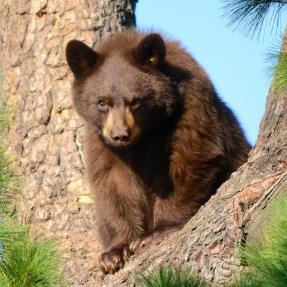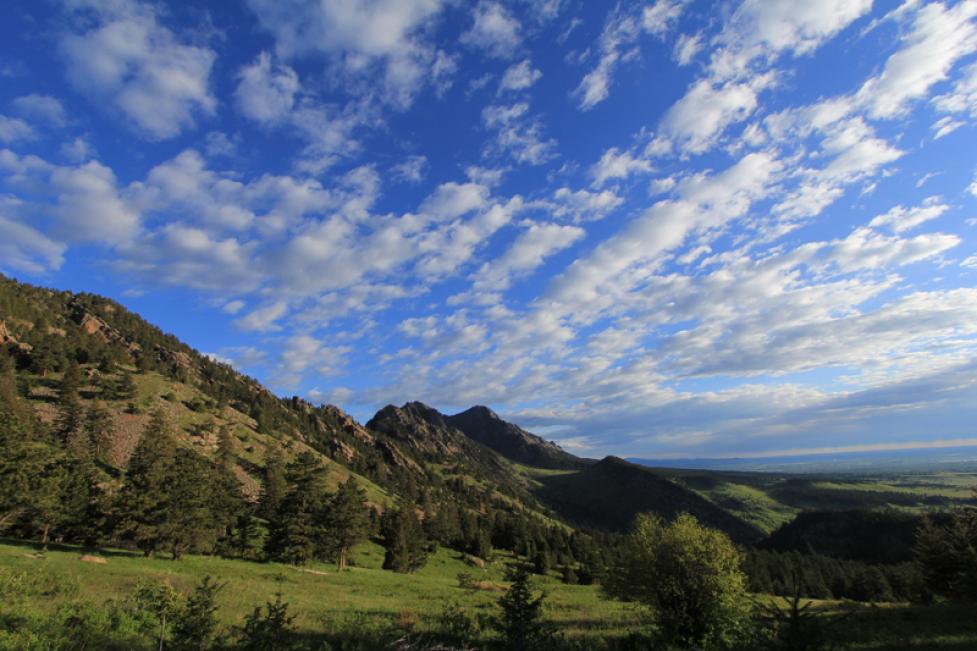October Favorite Hike – Gregory Canyon

Ann Duncan
Gregory Canyon in fall by Ann Duncan
Home to many deciduous trees and shrubs, Gregory Canyon puts on a spectacular autumn show. Cottonwoods and willows turn brilliant yellow. Other yellowing plants include tangles of wild grape (look for large, flat pointed leaves and clusters of tiny dark purple fruits), beaked hazelnut bushes and numerous apple trees planted early in the last century by Ernest Greenman. Leaves of American wild plums will turn a pale orange (look for their sour reddish fruit). Brilliant red shrubs also abound: smooth sumac turns intensely scarlet, as do the smooth leaves of chokecherries and the palmate leaves of Virginia Creeper vines. Among all the yellows, golds, reds and oranges, the green pines and firs add a lovely contrast. If you hike Gregory Canyon at this time, be on the lookout for black bears and know what to do if you meet one. Bears are attracted to the canyon because of the abundance of apples, plums, chokecherries, grapes and other wild fruits.
Why Leaves Change Colors
Colors in leaves come from pigments present in the leaf tissues. Chlorophyll is the pigment responsible for the green appearance of leaves, but other pigments are hiding inside beneath chlorophyll’s green mask. Cooler fall weather and shorter days tell plants that it’s time to cut back on chlorophyll production in preparation for winter. As the green pigments begin to break down, the other colors begin to show through. Yellow and orange colors come from pigments called carotenoids (note this word’s resemblance to “carrot”) which also give their colors to pumpkins, squash, daffodils and corn kernels. Another group of pigments, called anthocyanins, is responsible for intense reds and crimsons. These pigments form as sugars present in the leaf tissues break down.
Carotenoid levels remain fairly constant from year to year, so we don’t see much fluctuation in yellow intensities. But weather and temperature can greatly affect anthocyanins. A combination of warm, sunny days and dry cool nights produce the most spectacular displays of red and purple leaves. Warmth and sun activate a leaf’s remaining chlorophyll, causing it to produce large amounts of sugar. Cool nights cause the veins in the leaf to close down, preventing the sugar from moving into the rest of the plant. When large amounts of sugar get trapped in the leaf, they break down into anthocyanins and provide us with spectacular colors.
Lady Bird Swarms

If you visit one of the peaks in Boulder’s mountain backdrop this month, you may come upon the annual ladybug spectacle: thousands of these insects migrate to the peaks, where they join swarms that cover rocks and trees. The ladybugs, properly known as "lady bird beetles," are preparing to hibernate among rocky crevices and in dead trees. Hibernating in swarms may help the beetles conserve some body heat during the cold months.
About 475 species of lady bird beetles occur in North America. They come in various shades of red, orange, yellow and even pink! Adults are oval-shaped and most are speckled with black markings.
Contrary to popular myth, you can’t tell a lady bird’s age by counting the spots: each species has a particular number of spots which remains constant through the beetle’s life.
Most lady birds are ferocious predators. They eat small soft-bodied insect pests like aphids, mealy bugs, mites, and scale insects, chomping on scores in a given day. Scientists estimate that a single lady bird beetle may eat 5,000 aphids during its life! That’s a good friend to have in your garden.
The Monarch Migration

During fall, monarch butterflies visit Boulder as they pass through on their migration to warmer climes. The monarch may be the most familiar American butterfly. It has gotten a lot of publicity because of its migratory flights to Mexico and coastal California. Monarchs are bright orange, with a white-spotted black border with black-outlined veins. The male has a black dot in the middle of each hindwing -- actually a scent gland. Monarch caterpillars are dramatically ringed with yellow, black and white on each segment. Adults feed on and pollinate various species milkweeds but rarely breed in the Boulder area. So enjoy them while they pay us a short visit.
Why are monarchs colored like highway warning signs? To advertise their toxicity to would-be predators. Monarch caterpillars ingest toxic cardiac glycosides from their milkweed host plants. They store these chemicals in their bodies and retain them as adults. The adult butterflies add other poisonous alkaloid chemicals from various flowers. The result: monarchs are so toxic that they make birds vomit! Once a bird has eaten a monarch, it isn’t likely to repeat the mistake. Although a butterfly’s toxicity decreases with age, its bright and recognizable colors keep flashing a warning to birds: You’ll be sorry!
Eat, Drink and be Beary

Black bears are now putting on the fat they need to survive their long winter's sleep. During fall, bears must eat about 20,000 calories every day. That is the equivalent of 33 McDonald's Big Macs (at 600 calories each). Can you imagine having to eat that much every day during fall? As a result, bears spend about 20 hours a day foraging.
Because bears need a lot of high calorie food in a hurry, they are frequently drawn to human food sources like garbage cans, overflowing dumpsters and food stored outdoors in freezers or cars. Hungry bears may even try to break into homes or campers to satisfy their fall munchies. Bird feeders filled with seed or sugar solution, and pet food left on the back porch, will also attract bears to your backyard. Once bears get in the habit of visiting human neighborhoods for food, they become a safety risk to your family, pets and property. Often these bears have to be put down by wildlife officers to keep you safe.
Learn how to keep bears from visiting your home. You'll stay safe, and save a bear's life in the process!
The Last Word
"Autumn is a second spring when every leaf is a flower."
--Albert Camus
